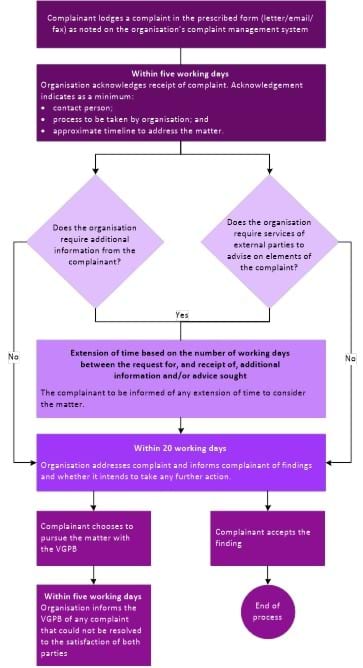Why have a complaints management system?
Effective handling of complaints demonstrates that an organisation places a high level of importance on the way it conducts procurement and how it interacts with the market.
A complaints management system gives a supplier involved in a procurement activity, or an agent acting in the interests of the supplier, mechanisms to raise concerns about how an organisation manages a procurement activity.
To maintain high standards of probity, complaints need to be handled in a consistent, fair and transparent manner. Complaints will ideally be resolved - to the satisfaction of both parties - within the organisation. Escalating complaints to outside parties can result in added costs and delays in delivering procurement activities.
Note: The complaint must relate to a procurement process issue. Matters of improper conduct, corruption or fraud etc. are to be dealt with under other existing channels for review.
Complaints management is part of the Governance - goods and services policy (see section 3). The policy requires an organisation to establish a complaints management system.
Setting up a complaints management system
A complaints management system sets out the process and procedures to be followed by the organisation when addressing a complaint.
An effective complaints management system will:
- incorporate complaints management into the organisation’s governance framework
- allocate responsibility to parties in the organisation for managing complaints
- provide publicly accessible information on how the organisation assesses complaints and the process for lodging complaints (format, extent of information required, where to lodge, contact details, the range of outcomes available to the organisation, etc.)
- ensure fair and transparent investigation
- keep the complainant informed about the timeframes for managing the complaint (Figure 1)
- provide the complainant with a response outlining the organisation’s findings and grounds for further action if required;
- provide grounds and avenues for escalating the matter for further review by the VGPB if the organisation’s findings are not accepted by the complainant
- make reference to other government bodies that may be able to assist (for example, Office of Small Business Commissioner, Office of the Ombudsman)
To demonstrate impartiality when investigating a complaint, the person managing the complaint needs appropriate knowledge of procurement policies and relevant processes. They must not be directly involved in the subject matter of the complaint.
Recommended schedule of timelines for managing complaints
A figure explains the recommended schedule of timelines for managing complaints.

The figure sets out the timelines for managing complaints in 10 steps. The following step-action table explains the contents of the figure.
Follow the 10 steps below for the recommended timelines for managing complaints:
| Step | Action |
|---|---|
| 1 | Complainant lodges a complaint in the prescribed form (letter / email / fax) as noted in the organisations complaint management system. |
| 2 | Within 5 working days Organisation acknowledges receipt of complaint. Acknowledgement indicates as a minimum;
|
| 3 | Does the organisation require additional information from the complainant? If yes, the go to step 4 If no, then go to step 6 |
| 4 | Does the organisation require the services of external parties to advise on elements of the complaint? If yes, go to step 5 If no, go to step 6 |
| 5 | Extension of time based on number of working days between the request for, and receipt of, additional information and / or advice sought |
| 6 | Within 20 working days Organisation addresses complaint and informs complainant of findings and whether it intends to take any further action |
| 7 | Does complainant accept the finding? If yes, go to step 8. If no, go to step 9 |
| 8 | End of process |
| 9 | Complainant chooses to pursue matter with the VGPB |
| 10 | Within 5 working days Organisation informs the VGPB of any complaint that could not be resolved to the satisfaction of both parties. |
Complaints referred to the VGPB
If the complaint cannot be resolved to the satisfaction of both parties, the complainant may refer the matter to the VGPB for review.
Note: To review a complaint, the VGPB requires certain information as listed in section 3.1.1 of the Governance - goods and services policy.
Using this guide
This guide accompanies the goods and services supply policies. There are 5 supply policies.
- Governance policy
- Complexity and capability assessment policy
- Market analysis and review policy
- Market approach policy
- Contract management and disclosure policy
This guide supports the Governance policy.
Tools and support
Access a document version of this guide in the Toolkit and library.
For more information about setting up a complaints management system for goods and services procurement, please contact the goods and services policy team.
Updated

